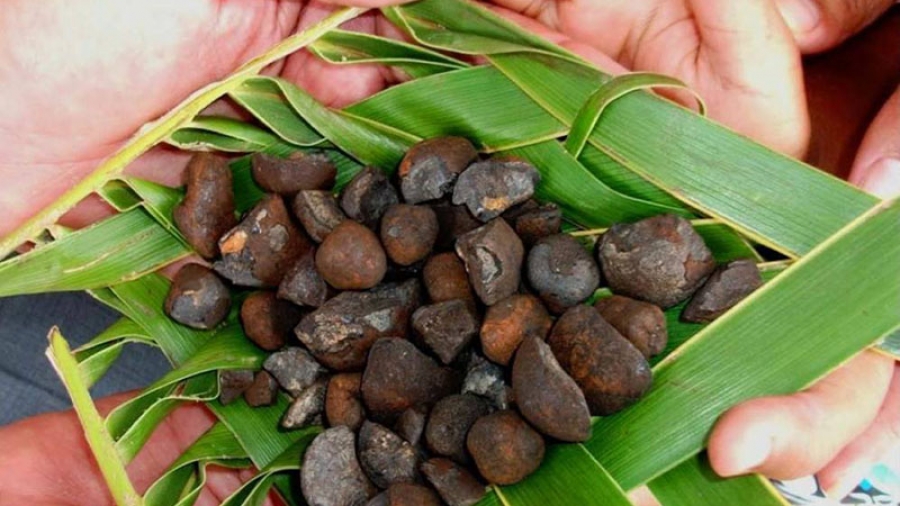OPINION: Predicting the impacts of deep seabed mining
Saturday 13 August 2022 | Written by Te Ipukarea Society | Published in Editorials, Opinion

Deep sea manganese nodules found in the Cook Islands Photo: EEZ. SEABED MINERALS AUTHORITY/20092117
This article comprises the conclusion from a report entitled ‘Prediction the Impact of Mining Deep Sea Polymetallic Nodules in the Pacific Ocean’.
The accumulated evidence from 250 peer reviewed scientific articles and other literature indicates that the impacts of nodule mining in the Pacific Ocean would be extensive, severe and last for generations, causing essentially irreversible damage.
The evidence does not support assertions that nodule mining would have minimal environmental impacts. Expectations that nodule mining would generate social and economic gains for Pacific island economies are based on conjecture and are unsubstantiated. The impacts of nodule mining on communities and people’s health and food security are understudied and require rigorous independent investigation.
The reference numbers in the text refer to references given in the full report. They are not included here for lack of space.
What science says about mining deep sea nodules in the Pacific:
Common human heritage
This review of 250 scientific and other sources finds that the mining of deep sea polymetallic nodules would result in severe and irreversible damage to deep sea ecosystems which include unique and largely unstudied species. It also finds that there are a great many under-researched and unknown variables that constitute a high degree of risk to marine ecosystems more broadly and to the people who rely on them.
These risks and uncertainties present a dilemma to decision-makers in the Pacific seeking to generate national income. The reality that confronts them is that it would be impossible to fully assess the social, cultural, economic and environmental impacts until after commercial mining has begun. By that stage, mitigating impacts could be difficult or ineffective. Many members of civil society in the Pacific therefore reject DSM (deep sea mining) as an experimental industry that treats islanders as its guinea pigs (178, 179).
Social and economic gains for Pacific island economies are unclear as the commercial viability of DSM ventures is unproven. A cost-benefit analysis of nodule mining in the Cook Islands indicates there is “a great deal of uncertainty around potential yields” as the technology is still experimental (25).
Investors, governments and communities would not know if benefits could be realised until significant economic, political, social and environmental capital has been expended. This risk has already had severe consequences for Papua New Guinea. Its experience with the failed Solwara 1 venture has added significantly to national debt, with government officials publicly stating regret for investing in the project (Section 5 Case Study). The project’s failure has led to calls for PNG to ban seabed mining in its waters and has reinforced calls for a regional Pacific moratorium on mining.
One of the biggest challenges in understanding the environmental impacts of nodule mining is that most assessments are theoretical and rely on modelling rather than empirical data. This is due to a dearth of research and the unprecedented nature of deep sea mining.
The trials of small-scale experimental disturbances are valuable and underscore the extremely slow recovery time in deep sea environments, as signs of recovery have yet to be seen several decades later. However, these trials are unable to replicate the range and scale of impacts that would result from commercial nodule mining.
Scientific knowledge is lacking in numerous areas and is insufficient to adequately understand the full range of impacts and risks associated with deep sea nodule mining and whether or not any of these can be managed.
Areas lacking key information include:
• Technologies and methods that would be used in nodule mining including the riser pipes and the depth of waste discharge (apart from minimal information from Belgian company Global Sea Mineral Resources — see Section 3 of full report);
• Volume of suspended sediment and mine waste that would be generated by the undefined technologies and methods, and their dispersal through ocean waters and across the seabed;
• Chemical reactions and ecotoxicological characteristics associated with sediment plumes and mine waste;
• Effects of nutrient loading on marine species in shallow, mid- and deep waters;
• Noise and light pollution produced by these undefined technologies and methods and their effects on species from the surface to the deep sea;
• Physical and ecological impacts on habitats, species and ecological processes of the deep sea as well as the water column extending to the surface - and hence the ecosystem services that may be lost;
• Impacts on pelagic species of the scattering layer (a dense body of pelagic species that make nightly migrations from deep to surface waters) which are important prey for many other species, including those commercially fished such as tuna;
• Population dynamics of deep sea species associated with nodules, especially with regard to their capacity to recolonise damaged areas;
• Migrations of deep sea fishes in the Pacific Ocean and the effect of nodule mining on such movements;
• Linkages between surface, mid and deep water ecosystems (including via migrations of deep sea fishes) and the communication of impacts between them;
• Risks for fisheries of high global, regional, national and local economic value in the Pacific;
• Cumulative and trans-jurisdictional impacts on species, habitats and ecosystems;
• Adequacy of proposed conservation measures such as Areas of Particular Environmental Interest established by the International Seabed Authority in the Clarion Clipperton Zone or biological reference zones proposed within each mining lease (see Section 2.3.1 of full report).
This is critical given that remediation of the physical impacts of nodule mining is viewed as unrealistic;
• Effects of nodule mining on carbon cycling and storage; and
• Social and economic costs and benefits to Pacific island economies.
- The full report can be found on the Secretariat for the Pacific Regional Environment Program website: https://www.sprep.org/sites/default/files/documents/publications/Nodule-Mining-in-the-Pacific-Ocean.pdf














































